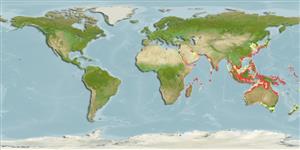Common names from other countries
Environment: milieu / climate zone / depth range / distribution range
Ecología
marino; agua dulce; salobre; potamodromo (Ref. 51243); rango de profundidad 0 - ? m. Tropical
Indo-West Pacific: Persian Gulf to China along the mainland coast of Asia. Replaced in the East Indies, Borneo, and the Philippines by Hyporhamphus neglectus and around northern Australia and southern New Guinea by Hyporhamphus neglectissimus.
Length at first maturity / Tamaño / Peso / Age
Maturity: Lm ?, range 9 - ? cm
Max length : 35.0 cm TL macho / no sexado; (Ref. 85009); common length : 13.0 cm SL macho / no sexado; (Ref. 9843)
Espinas dorsales (total) : 0; Radios blandos dorsales (total) : 13 - 16; Espinas anales: 0; Radios blandos anales: 13 - 16. Greatly prolonged, beak-like lower jaw, equal to, or longer than head length; upper jaw short, triangular and scaly, its width 0.6-0.8 times in its length. Preorbital distance 1.3-2.1 times in diameter of orbit and 0.75-1.2 times in length of upper jaw. Total number of gill rakers on first gill arch 23-37. Anal fin rays 13-16; caudal fin emarginate, not strongly forked.
Coastal species. Found at surface levels of tidal freshwaters and brackish estuaries (Ref. 12693). Encountered in the Mekong as far upstream as Stung Treng and also found in the Great Lake, Cambodia (Ref. 12693). Feed mainly on insects (Ref. 12693, 33813). Marketed fresh and dried salted.
Life cycle and mating behavior
Maturities | Reproducción | Spawnings | Egg(s) | Fecundities | Larva
Collette, B.B. and J. Su, 1986. The halfbeaks (Pisces, Beloniformes, Hemiramphidae) of the Far East. Proc. Acad. Nat. Sci. Philadelphia 138(1):250-301. (Ref. 10943)
IUCN Red List Status (Ref. 130435)
CITES (Ref. 128078)
Not Evaluated
Threat to humans
Harmless
Human uses
Pesquerías: escaso valor comercial
Herramientas
Special reports
Download XML
Fuentes de Internet
Estimates based on models
Preferred temperature (Ref.
115969): 24.8 - 29.2, mean 28.3 (based on 1334 cells).
Phylogenetic diversity index (Ref.
82804): PD
50 = 0.5000 [Uniqueness, from 0.5 = low to 2.0 = high].
Bayesian length-weight: a=0.00427 (0.00254 - 0.00717), b=3.06 (2.92 - 3.20), in cm Total Length, based on LWR estimates for this species & Genus-body shape (Ref.
93245).
Nivel trófico (Ref.
69278): 3.1 ±0.1 se; based on diet studies.
Resiliencia (Ref.
120179): Alto, población duplicada en un tiempo mínimo inferior a 15 meses (Preliminary K or Fecundity.).
Fishing Vulnerability (Ref.
59153): Low vulnerability (25 of 100).
